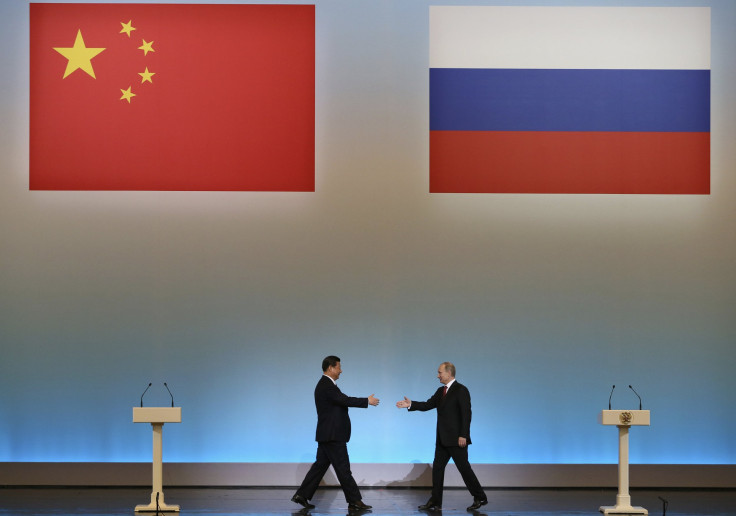Korea, India And Japan, Not Just China, Are Looking To Russia For Energy

When Russian President Vladimir Putin visits Beijing on Tuesday, he’s expected to sign a multibillion-dollar deal with China to build a natural gas pipeline after more than a decade of negotiations and over U.S. objections that China is undermining Western sanctions against Russia stemming from the Ukraine crisis.
It may be the first of many such energy deals in the region as Putin looks to the East to bypass the sanctions. Already the sanctions have led some American oil and gas executives to skip an upcoming economic conference in Russia. The deal between Russia’s state gas company, Gazprom, and China’s state oil and gas company, CNPC, allows Russia to diversify its customer base, which is heavily dependent on sales to Europe.
Aware that it could lose market share in Europe -- within 10 years, North American natural gas could ship to Europe -- Russia has been looking to Asian and East Asian markets, where demand for energy imports is rapidly growing.
“Japanese, Indian and Korean companies are increasing their interest and involvement in Russia’s energy sector,” Kyle Davis, an energy expert at international law firm Goltsblat BLP, said. “Strategically it makes sense, whether things are going well with the West or not.”
In late April, Russia's parliament voted to forgive North Korea 90 percent of its debt to Russia, which dated back to the Soviet era when the two nations were allies during the Cold War. Instead, it voted to invest $1 billion in the world’s most-secretive country for health care, education and energy projects. The planned energy project is a major natural gas pipeline through North Korea.
Russia plans to build a gas pipeline and accompanying railroad from its offshore Sakhalin Island fields, north of Japan, through North Korea to South Korea.
“Obviously, the greatest variable in this project is the North Korean risk, which must be handled effectively,” Chris Faulkner, CEO of Texas-based Breitling Energy and adviser to the Energy China Forum’s Asia Shale Gas Committee, said. “North Korea is not trustworthy enough to entrust with an energy supply line, and inter-Korean relations are not healthy enough at present to carry out this project.”
ExxonMobil operates one of the Sakhalin fields with a 30 percent stake, partnering with companies from Japan (30 percent stake), India (20 percent) and two Russian companies (20 percent combined). Subsidiaries of Gazprom, Netherlands-based Royal Dutch Shell, Japanese corporate group Mitsui and Japanese auto manufacturer Mitsubishi operate the other field. The project is expected to supply South Korea with 10 billion cubic meters of gas each year. It's expected to make North Korea into a sort of Ukraine, and it's expected to make South Korea akin to Europe with its present dependence on Russian gas.
South Korea relies on imports to meet about 97 percent of its energy needs, making it the world’s second-largest natural gas importer behind Japan.
"Seems to me Putin is using the Korean project to put pressure on the Chinese to make up their mind," Gal Luft, co-director of the Institute for the Analysis of Global Security and senior adviser to the U.S. Energy Security Council, said. "For him the big prize is China and this week's visit is crucial."
Russia and India have been negotiating to build a $30 billion oil pipeline, which would be the world's most expensive due to its proposed route through rugged terrain. The so-called Silk Road pipeline would link Russia’s Altai Mountain region to the Xinjiang province of China and northern India. Russia exports 70 percent of its oil, compared to 30 percent of its gas production, and its oil revenues are nearly seven times its gas revenues, the U.S. Energy Information Administration (EIA) said.
India is the third-largest oil importer in the world after the U.S. and China, as it relies on imports from the Middle East, and it's projected to become the world’s largest oil importer by 2020, according to the EIA. China and India’s economies have been among the world’s fastest-growing for the past two decades, and like China, India’s energy consumption has more than doubled since 1990. Unsurprisingly, India is aiming to secure additional energy imports and to diversify its energy supply.
As the Asian Development Bank pointed out in an October 2013 report, energy pricing in India is a core hindrance to foreign investment, as oil prices are government-controlled and do not fully reflect the procurement prices.
Nonetheless, Russia has not called off the project, which it began planning around the same time that China and Russia began discussing a gas pipeline. Indian Prime Minister Manmohan Singh and Putin issued a joint statement from Moscow on Oct. 21, 2013, that confirmed that the two nations are collaborating “to study the possibility of direct ground transportation of hydrocarbons.”
The statement reaffirmed a joint commitment made in 2010. A year earlier, foreign ministers from Russia, India and China agreed to enhance energy cooperation among the two countries, and at the end of last year, India’s biggest oil and gas company, Oil and Natural Gas Corp. (ONGC), confirmed its interest in the pipeline from Russia, calling it “appropriate.”
Talks about the pipeline's construction are expected to conclude by the middle of this year, with a completion date of 2020-2022, according to the Center for Research on Globalization, a Montreal-based nonprofit.
Still, China remains Russia’s most promising customer, with oil and gas consumption expected to increase by nearly 90 percent in 2011-2020, while India’s consumption is expected to rise by about 50 percent, according to The Economist’s Intelligence Unit.
“Until a China pipeline is built, Russia has few export markets for gas outside of Europe, leaving it vulnerable to sanctions and competition from U.S. exports of shale gas, and Putin knows this,” Faulkner said.
© Copyright IBTimes 2024. All rights reserved.




















